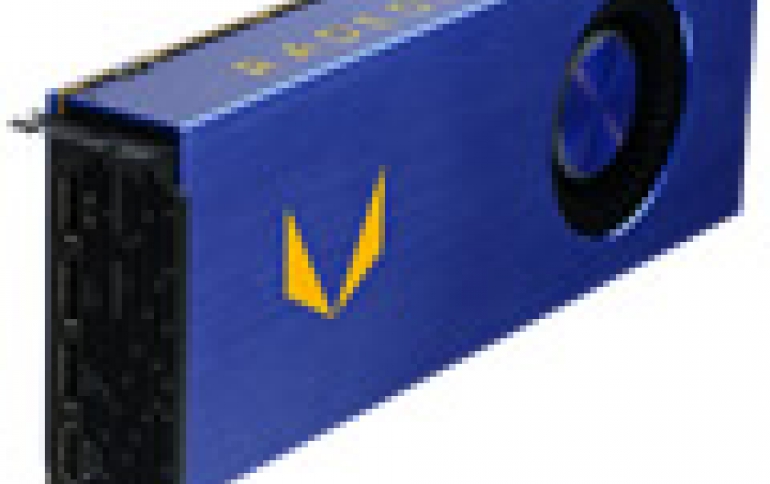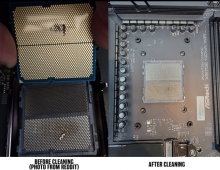
AMD Radeon Vega Frontier Edition Launches for $1,000
AMD today unleashed the first product based on its "Vega" graphics processing unit (GPU) architecture. The Radeon Vega Frontier Edition graphics card has been designed to empower the next generation of data scientists, game designers and visualization professionals.
AMD claims that its new graphics card offers an up to 172 percent faster rendering performance in in Maya 2017 GPGPU tests compared to the rival NVIDIA GeForce Titan Xp.
The card is clocked at 1382MHz with its peak GPU clock to hit the 1600MHz. Feeding the GPU is AMD's dual stack HBM2 configuration, which is now confirmed to be a pair of 8 layer, 8GB "8-Hi" stacks. AMD has the Vega FE's memory clocked at just under 1.9Gbps, which gives the card a total memory bandwidth of 483GB/sec. As for power consumption, AMD lists the card's typical board power as "< 300W".
The card's display connectors are 3x DP 1.4 ports along with 1x HDMI port. AMD is also throwing in a passive DP to SL-DVI adapter in the box.
Through its High Bandwidth Cache Controller, the cornerstone of AMD's HBM2 GPU memory architecture, the Radeon Vega Frontier Edition expands the capacity of traditional GPU memory to 256TB, allowing users to tackle massive datasets with ease. AMD's tested the new card in the DeepBench Benchmark and compared it with the Nvidia Tesla P100. According to AMD, the Radeon Vega Frontier Edition scored up to 33 percent faster than the competition. The DeepBench benchmark measures the performance of basic operations involved in training deep neural networks.
AMD wants to take the leadign role in the fields like artificial intelligence (AI), by promoting the new graphics card along with the open-source, fully scalable ROCm software platform. Developers can use the power of the "Vega" architecture for machine learning algorithm development on the Radeon Vega Frontier Edition fast, before deploying it out to massive servers.

In order to further underline the horsepower provided by the Vega Frontier Edition in the design of large and complex models and the deployment of real-time visualization, AMD says that it new GPU offers great multi-GPU scaling, with 91 percent faster rendering using two Radeon Vega Frontier Edition GPUs.
With the Radeon Pro Settings user interface, users can switch between "Radeon Pro Mode" and "Gaming Mode" to alternate between development on animation applications like Autodesk Maya and performance optimizations with free, open source tools available through AMD's GPUOpen initiative.
In addition, AMD's fastest Radeon VR Ready Creator graphics card ever, achieves the maximum possible score in the SteamVR benchmark, up to 21 percent higher than the multi-GPU Radeon Pro Duo solution. Combined with Radeon Loom, AMD's 360-degree video stitching technology, creators can stitch high-resolution video in real time.
Radeon Vega Frontier Edition graphics cards are available from etailers in select regions today with an SEP of $999 USD for the air-cooled edition. The water-cooled edition is expected to launch in Q3 with an SEP of $1499.
GPU
- Compute Units: 64 nCU
- Typical Engine Clock (MHz): 1382
- Peak Engine Clock (MHz): 1600
- Peak Half Precision Compute Performance: 26.2TFLOPS
- Peak Single Precision Compute Performance: 13.1TFLOPS
- Peak Double Precision Compute Performance: 819GFLOPS
- Stream Processors: 4096
- Peak Triangle/s (BT/s): 6.4 10-bit
- Display Support: Yes
Requirements
- Typical Board Power: <300W
- PSU Recommendation: >850W
- Required PCI Slots: 2
Memory
- Memory Data Rate: 1.89Gbps
- Memory Speed (Effective): 945MHz
- Memory Size: 16GB
- Memory Type: HBC
- Memory Interface: 2048-bit
- Memory Bandwidth: 483GB/s
Supported Rendering Format
- H265/HEVC Decode: 8 HD / 4K60 H265/HEVC
- Encode: 1080p240 or 4K60 Mxed with Decode
Connectivity: Adapters included in Box1x DP-DVI SL (passive)
Features: OpenCL 2.0, OpenGL 4.5, Vulkan API, AMD Eyefinity Technology, AMD PowerTune Technology, ZeroCore Power Technology, 5K Support (60Hz SST), 8K30 Support, AMD FreeSync Technology, Support TrueAudio Next technology, Bezel Compensation, Partially Resident Textures





















